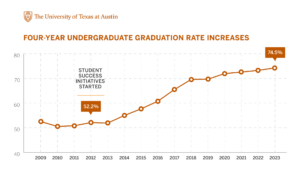In 2011, the University embarked on an ambitious campaign to help undergraduate students succeed and to increase the University’s four-year graduation rate from 51% to 70% by 2017. Student Success Initiatives was created in 2012 to develop programs to improve the educational experience for students and to support that goal.
By 2017, UT’s four-year graduation rate rose to 65.7%, and Every Student Graduates was released, a comprehensive report that details the work done by OSS, partners in UT’s colleges, schools and units, and the campus at large in the first five years since the goal was set.
Since 2017, UT’s four-year graduation rate has continued its steady climb, reaching 74.5% in 2023. Notably, four-year graduation rates for first-generation and Pell-eligible students continue to increase, as well. For first-generation students, the four-year graduation rate rose from 39.7% in 2013 to 66.1% in 2023. For Pell-eligible students, the four-year graduation rate reached 67.9% in 2023, compared with 40.2% 10 years earlier in 2013.
Overall six-year graduation rates have improved as well, reaching 87.6% in 2023.
The Office of Student Success has evolved from these beginnings and works with campus partners to provide students with academic and advising support, wraparound services and resources to help students navigate institutional requirements. We provide data and support to colleges and schools in their efforts to improve graduation, retention and persistence rates and to streamline the educational experience for all undergraduates.

Access and Support
Together with colleagues across campus, OSS uses predictive analytics to identify incoming students who can benefit from scholarship funds, co-enrollment opportunities, academic support programs, peer mentoring and more.
College, School, and Units Success Programs
Approximately 2,000 freshmen, identified through predictive modeling, join success programs within UT’s colleges, schools and units each year, including:
- Fine Arts Mentoring & Enrichment (FAME) Program, College of Fine Arts
- Foundation Scholars, College of Liberal Arts
- McCombs Success Scholars, McCombs School of Business
- Ramshorn Scholars, Cockrell School of Engineering
- School of Architecture Success, School of Architecture
- Social Work SWEEP, Steve Hicks School of Social Work
- Texas Education Scholars, College of Education
- Texas Interdisciplinary Program (TIP), College of Natural Sciences
First-Year Connections
Every incoming Longhorn is invited to be part of a First-Year Connection — a group of approximately 20 first-year students who meet weekly to discuss their college experiences.
Path to Admission through Co-Enrollment (PACE)
A partnership between UT and Austin Community College, Path to Admission Through Co-Enrollment (PACE) gives students the opportunity to attend small classes in a supportive learning environment and at the same time gain access to game-changing resources available only at a world-class university.
Texas Advance Commitment
The Texas Advance Commitment is the university’s commitment to ensuring a UT education is even more affordable for Texas students. By making financial aid more transparent, the Texas Advance Commitment helps students with financial need understand that they will receive financial assistance. Completion Scholarships, Impact Scholarships and the University Leadership Network all are signature scholarship programs through which Texas Advance Commitment funds can be awarded.

